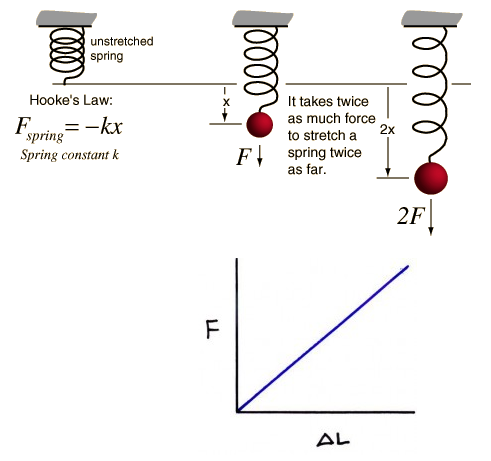05
-
- Introduction
- This week we will be looking at the mechanical properties of materials, not only the theory but also in the laboratory.
- Study Plan
- Study:
1. Read over week 5 lecture presentation
2. Read chapter 6.1-6.6, and 6.10 in Callister
3. Work through the questions on page 42 of the study pack and other relevant questions at the end of the chapter in Callister
Activity:
1. Look at the videos referenced in the study pack
2. Undertake the laboratory experiments on the mechanical properties of some common metals and write a lab report based on the work undertaken. This material will be used in the class test next week
3. View the VMSE on Tensile Testing of each of the metals -
- Stress and Strain
- The ideas above only apply in specific circumstances. i.e. that particular experiment. When we undertake an experiment to determine the tensile properties of metals, we use a standard test specimen. The force divided by the original area gives us STRESS , the extension divided by the gauge length gives us STRAIN
So the previous graphical representation of Hooke’s law using these new parameters where:
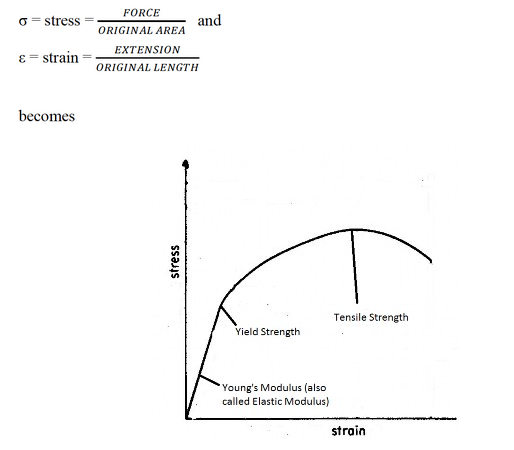
Tensile stress vs strain graph (YouTube)
Definitions:
Tensile Strength: a materials ability to resist a tensile stress,
Yield Strength: the stress at which the material changed from elastic to plastic deformation, Elastic Modules: a measure of a materials stiffness (taking into account the geometry of the specimen)
These are all measured by undertaking a Tensile Test
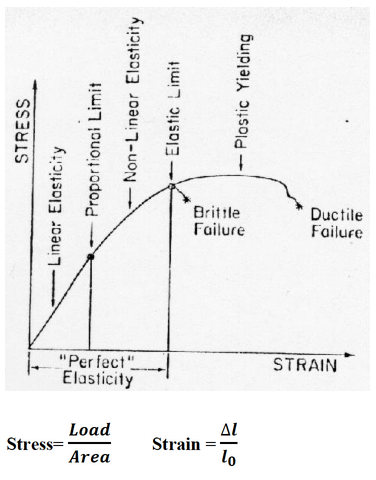
Ductility: refers to the degree of extension which takes place before failure of a material in tension.
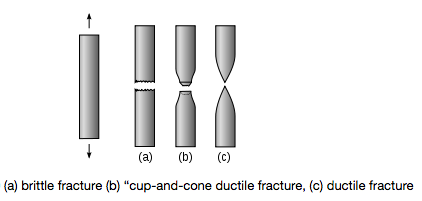
Malleability: refers to the extent to which a material can undergo deformation in compression before failure occurs.
All ductile materials are malleable, but malleable materials are not necessarily always ductile since soft material may lack strength and thus tear apart very easily in tension.
Toughness : The area under the stress-strain curve can be found as 1 x σ x ε.
This has units Nm-2 or Jm-3 i.e. energy per unit volume. This is termed TOUGHNESS
This is measured in terms of the amount of energy required to fracture a standard test piece. It MUST NOT, therefore be confused with strength which is measured in terms of STRESS required to break a standard test piece.
Energy is related to the area under the stress/strain curve.
- The method of testing the toughness of a material is called IMPACT TESTING.
A portion of the kinetic energy of a swinging pendulum is absorbed in fracturing a standard suitably notched test piece in both the IZOD and CHARPY -
- Methods of measuring impact toughness
The unit of energy employed is the JOULE. These tests offer a useful practical indication of how a material will react to conditions of shock loading, and in many circumstances toughness will be more important than tensile strength as a criterion of suitability of a material.
The material below is said to have high toughness and is called a DUCTILE material.

Hardness: The ability of a material to resist surface abrasion.
The hardness of minerals has been assessed by reference to MOH's scale:
Mineral Hardness Index Diamond 10 Corundum 9 Topaz 8 Quartz 7 Orthoclase Feldspar 6 Apatite 5 Fluorite 4 Calcite 3 Gypsum 2 Talc 1
The surface hardness of any substance can be related to MOH's scale by determining which of these standard substances will just scratch it. This is generally a qualitative hardness test, and is not useful for the accurate determination of the hardness of a material.
For the accurate determination of the hardness of a material, engineers use machines which measure the resistance of the surface layers of a material to penetration by some form of indenter. In the Brinell test, the indenter is a steel ball, whilst in the diamond pyramid test a pyramidal diamond is used. The Rockwell test employs a diamond cone or steel ball. In each case the hardness index (H) is given by:
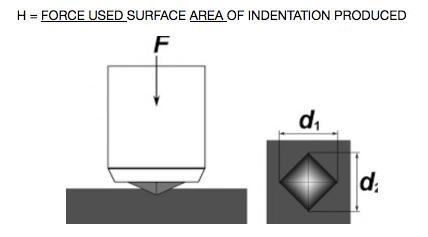
Brinell test video Rockwell test video
FATIGUE
This refers to the failure of a material under the action of repeated or fluctuating stresses.
Fatigue failure may occur due to the propagation of cracks, probably initiated at a point of high mechanical stress.
CREEP
This is defined as the continuing deformation, with the passage of time, in materials subjected to constant stress. This deformation is plastic and occurs even although the acting stress is below the yield stress of the material.
This type of deformation is very dependent on the ambient temperature. At temperatures below 0.4 T (T is Tm of the material on the Kelvin scale), the rate of creep is very small, but at temperatures higher than this it becomes increasingly important.
For this reason creep is commonly regarded as being a high temperature phenomenon associated with steam plant and gas-turbine technology. Nevertheless with some of the soft, low melting point metals and alloys, creep will occur significantly at ambient temperatures. Some examples of this are:
1. lead roofs laid centuries ago are measurably thicker at the eaves than at the apex.
2. glass windows (glass is not a solid ) tend to be thicker at the bottom than at the top, after many decades. -
- Elastic and plastic deformation
Elastic deformation
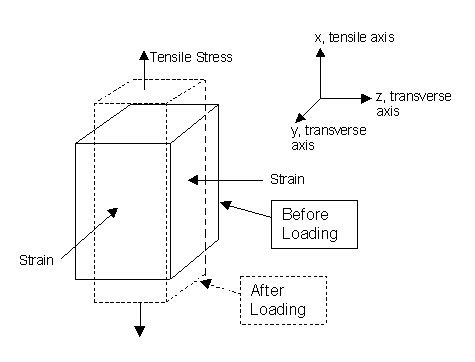
This is applied where a load is applied to a material producing an extension and when the load is withdrawn the material resorts to its original length. This can be shown schematically.
Plastic deformation
This occurs when a load is applied greater than that used above. The extension thus produced does not disappear when the applied load is withdrawn. This is because the applied load is greater than that required to cause elastic deformation, i.e. L1 > L2.
(If you think of moulding Plasticine, it easily takes up and maintains any shape which it is endowed with.)
Work hardening
If you have ever attempted to sever the top of a tin can from the body of the can, you will have realised that as time goes on, it gets harder to bend the metal before it ultimately fractures. This can be explained by considering what happens at the yield point. At this point on the stress/strain curve the dislocations slip and the built-in stress is relieved, resulting in the previously ductile material becoming brittle and undergoes brittle fracture.
Work hardening is achieved by cyclic loading and unloading to and from the yield point of the material. As deformation proceeds, whether by slip or twining, the metal becomes harder and stronger and a stage is reached where further deformation is impossible. Any increase in stress will lead only to fracture. At this stage, when tensile strength and hardness are at a maximum and ductility is at a minimum, the material is said to be WORK HARDENED.
Here is a review video on the definitions used -
-
- Mechanical properties tutorial
- 1. Describe the effect each of the following has on the mechanical properties of a material: (lab based exercise)
1. alloying;
2. cold working;
3. increasing Carbon content in a Steel;
4. quenching;
5. drawing a polymer. (you can do this after the polymer lab in week 11)
2. Define the following terms in relation to material properties:
1. Strength
2. Toughness
3. Ductility
4. Yield point
5. Hardness
3. Describe the possible tests which may be undertaken to ascertain the fitness for purpose of a material before it goes into service.
Explain the significance of the information obtained.
